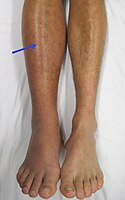
Photo from wikipedia
Supplemental Digital Content is available in the text. The relative efficacy of bridging with low-molecular-weight heparin (LMWH) or unfractionated heparin (UFH) in left ventricular assist device (LVAD) patients has not… Click to show full abstract
Supplemental Digital Content is available in the text. The relative efficacy of bridging with low-molecular-weight heparin (LMWH) or unfractionated heparin (UFH) in left ventricular assist device (LVAD) patients has not been established. We performed a retrospective, longitudinal cohort study to evaluate safety and efficacy of bridging strategies including all adult LVAD patients implanted at the Medical University of South Carolina from August 2014 to July 2017. In addition to LMWH and UFH exposure, we recorded any time period a patient did not receive a bridging agent for a subtherapeutic international normalized ratio (INR) value as a control group; these events were defined as nonbridging (NB) events. Multivariable Cox regression survival models were utilized for analysis. There were 563 episodes evaluated in 50 patients. Compared with NB events, UFH (adjusted hazard ratio [aHR], 3.75; 95% CI, 1.45–9.73; p = 0.007) and LMWH (aHR, 2.25; 95% CI, 1.03–4.94; p = 0.043) were both associated with an increased risk of bleeding. Compared with NB events, LMWH was not associated with a decreased risk of clotting events (aHR, 1.56; 95% CI, 0.28–8.73; p = 0.616). In the 381 NB events, a nonsignificant signal was noted toward increased risk of thrombotic events in those with an INR ≤ 1.5 (aHR, 2.99; 95% CI, 0.57–15.8; p = 0.2). Among all 563 episodes, those with a baseline INR ≥ 2.0 demonstrated an increased risk of bleeding events (aHR, 2.35; 95% CI, 1.18–5.69; p = 0.016). Our data suggest that the efficacy of LMWH bridging in LVAD patients warrants further investigation.
Journal Title: ASAIO Journal
Year Published: 2021
Link to full text (if available)
Share on Social Media: Sign Up to like & get
recommendations!